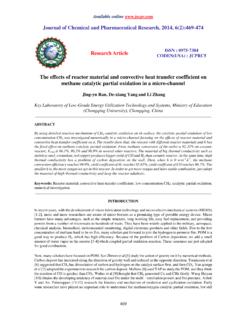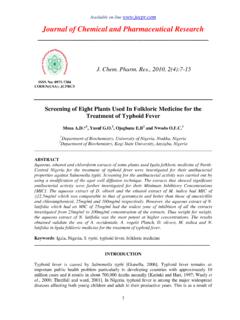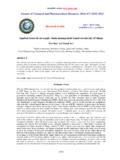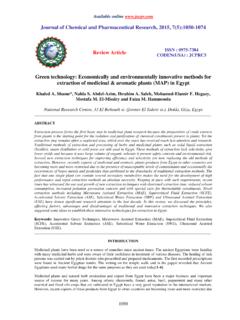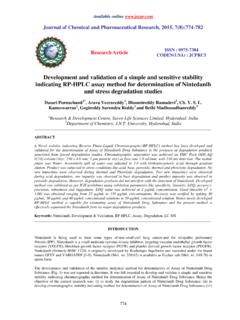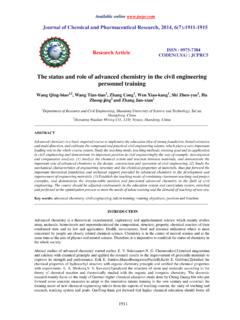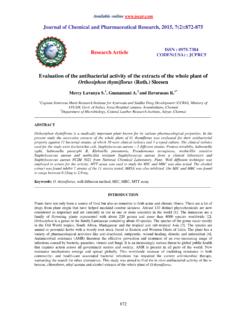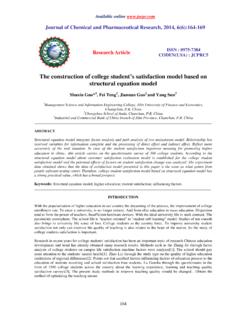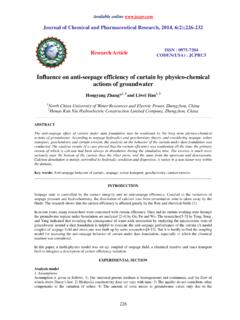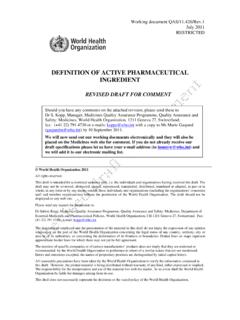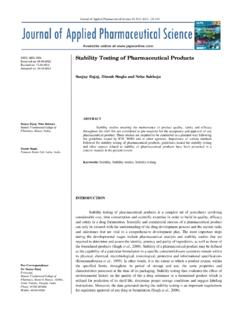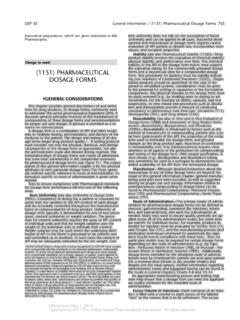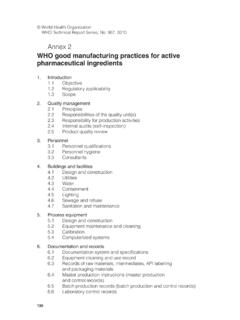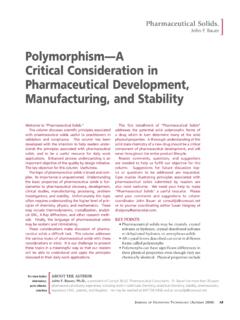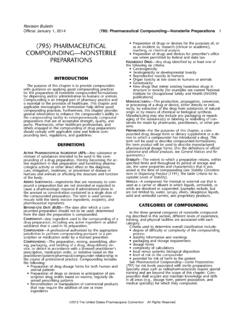Transcription of JCPRC5 - Pharmaceutical Research
1 Available online Journal of Chemical and Pharmaceutical Research , 2015, 7(9):180-185 ISSN : 0975-7384 CODEN(USA) : JCPRC5 In-process and finished products quality control tests for Pharmaceutical tablets according to Pharmacopoeias Md. Sahab Uddin*, Abdullah Al Mamun, Tanjuma Tasnu and Md. Asaduzzaman Department of Pharmacy, Southeast University, Dhaka-1213, Bangladesh ABSTRACT A Pharmaceutical tablet must satisfy certain standards to claim it to be a quality drug. The main criteria for quality of any drug in dosage form are its safety, potency, efficacy, stability, patient acceptability and regulatory compliance. The quality of a Pharmaceutical tablet needs to be designed from the product development stage. At the product design and formulation stage the physical, chemical and biological specifications, to which the product must comply with to fulfill quality requirements, have to determine and the target for quality must be set.
2 In-process quality control (IPQC) tests are strongly related to final product quality because checks performed during production in order to monitor and if necessary to adjust the process to ensure that the product conforms to its specification are the key for good quality Pharmaceutical tablets. The purposes of IPQC are to produce a perfect finished product by preventing or eliminating errors at every stage in production. After the manufacturing process is complete finished product quality control (FPQC) tests for Pharmaceutical tablets are performed with respect to specification of the pharmacopoeias in order to check that the quality parameters are within acceptance limits or not. The aim of this study is to provide in-process and finished product quality control tests for Pharmaceutical tablets according to pharmacopoeias.
3 Keywords: Pharmaceutical tablets, Pharmacopoeia, In-process quality control, Finished product quality control, Specification INTRODUCTION Quality is not an accident this is the result of intelligent effort [1]. The quality in the Pharmaceutical industry has become a very important and sensitive issue. Since the world has gathered together to unite its practices, guides and the launching of the Food and Drug Administration (FDA) current good manufacturing practices (cGMP) for the 21st century - there has been a growing awareness for the significance of the quality of the Pharmaceutical products. In the Pharmaceutical industry, it is essential for controlling the errors during the every stage in production process since total quality of the product must be ensured according to compendia of drugs [2].
4 Manufacturing practices which result in good quality finished products and has adequate considerations for safety of the employees is recognized as GMP. GMP is concerned with both production and quality control (QC) [3]. QC is the part of GMP by which QC personnel analyses the quality of all factors involved in production in order to eliminate errors at every stage in production. The purposes of QC are to produce a perfect finished product by preventing or eliminating errors at every stage in production. QC is a team work and we have to remember that quality must be built into a drug product during product and process design and it is influenced by the physical plant design, space, ventilation, cleanliness and sanitation during routine production [4].
5 IPQC tests are performed at regular intervals (generally each 1 hr later) during the manufacturing process [5]. The objectives of IPQC involve monitoring and alteration of the manufacturing process if necessary with a vision to comply with the specifications. The control of the environment or equipment may also be regarded as a part of in- 180 Review Article Md. Sahab Uddin et al J. Chem. Pharm. Res., 2015, 7(9):180-185 181 process control (IPC). They should not carry any risk for the quality of product. In process testing enables easier identification of problems. It sometime identifies a defective product batch that can be corrected by rework, whereas once that batch has been completed, this may not be possible. Failure to meet IPC specification indicates either those procedures were not followed or some factors were out of control [6].
6 Standard operating procedures (SOPs) should be established in the Pharmaceutical industry and followed that describe the IPQCs and tests [7]. FPQCs are tests that are performed when the manufacturing process is completed in order to check qualitative and quantitative characteristics along with test procedures and their acceptable limits by which the finished product must comply throughout its valid shelf-life [8]. In order to determine the specifications of the finished product, the quality characteristics related to the manufacturing process should be taken into account. An appropriate specification for each aspect of quality studied during the phase of development and during the validation of the manufacturing process should be determined. At least those aspects considered to be critical should be the object of specifications routinely verified.
7 The specification limits of the finished product at the time of batch release are set by the marketing authorization applicant such that the specifications proposed at the end of shelf-life are guaranteed and are established on the basis of a critical detailed review of the data gathered from the batches analyzed [9]. Pharmacopoeias are called drugs standard [10]. There are various types of pharmacopoeia such as Indian Pharmacopoeia (IP), British Pharmacopoeia (BP), United States Pharmacopoeia (USP), European Pharmacopoeia (PhEur), International Pharmacopoeia (PhInt) and Japanese Pharmacopoeia (JP) in different parts of the world and they have laid down the specified limits within which the value should fall in order to be compliant as per the standards.
8 The objective of this study is to show the quality parameters for Pharmaceutical tablets according to pharmacopoeias that are part of in-process and finished product quality control tests. UNIVERSAL TESTS FOR Pharmaceutical TABLETS The tablet dosage form accounts for approximately 50% of all dosage forms on the market [11]. There are four tests that are generally applicable to Pharmaceutical tablets and other drug products: Description This test is often called appearance on a specification and is a qualitative description of the Pharmaceutical tablet. For example, the description of a tablet on a specification may read: white, round, biconvex, film-coated tablet, imprinted with Rx on one side [12]. Identification The purpose of an identification or identity test is to verify the identity of the active Pharmaceutical ingredient (API) in the Pharmaceutical tablet.
9 This test should be able to discriminate between compounds of closely related structures that are likely to be present [12]. Assay This test determines the strength or content of the API in the Pharmaceutical tablet and is sometimes called a content test [12]. Impurities This test determines the presence of any component that is not the API or an excipient of Pharmaceutical tablet. The most common type of impurities that are measured is related substances, which are processed impurities from the new drug substance synthesis, degradation products of the API, or both [12]. IPQC AND FPQC TEST FOR Pharmaceutical TABLETS Physical parameters of Pharmaceutical tablets that are controlled by IPQC tests are temperature, pressure, moisture content, time, weight, particle size, hardness, loss on drying, disintegration time, color, compactness, integrity etc.
10 FPQC test for Pharmaceutical tablets are assay, uniformity of content, uniformity of mass, weight variation, friability test, content of active ingredients , hardness test, disintegration test, dissolution test etc. IPQC and FPQC test for Pharmaceutical tablets according to pharmacopoeias are listed below: Size and Shape The size and shape of the tablet can be dimensionally described monitored and controlled. It is determined by the tooling during the compression process [11]. Md. Sahab Uddin et al J. Chem. Pharm. Res., 2015, 7(9):180-185 182 Color and Odor Many Pharmaceutical tablets use color as a vital means of rapid identification and consumer acceptance. But it must be uniform within a single tablet, from tablet to tablet and from lot to lot.
